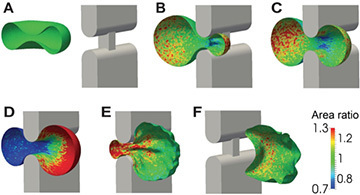
During its 120-day cycle the circulatory system transports red blood cells and nutrients throughout the human body. This system helps keep the body in balance and fight against infections and diseases by filtering old or diseased blood cells and other foreign bodies. As blood flows through the body, the individual cells must often squeeze through tiny passages. According to Zhangli Peng, assistant professor in the Department of Aerospace and Mechanical Engineering at the University of Notre Dame, some of the smallest of these are found in spleen. Since the spleen also plays a critical role in determining the size and shape of healthy blood cells, it is the ideal organ through which to study cell movement or transmigration.
Peng, co-investigator Juan del Alamo of the University of California at San Diego, and their team are studying the transmigration of red blood cells through inter-endothelial slits in the spleen, the narrowest point in the body through which these cells travel. Their collaborative research project, “Multi-scale Models and Quantitative Experiments of Red Blood Cells Transmigration through Inter-endothelial Slits in the Spleen,” is being funded by the National Science Foundation.
 Zhangli Peng
Zhangli Peng
“Just like any ‘flow,’ says Peng, “blood cells moving through the body adapt to the available space. As the blood vessels and capillaries change in size the cells experience significant mechanical forces which can affect their structure — this is called cell deformation and remodeling, depending on the cell volume and flow rate. At times cells may even rupture. We are working to develop a model of these reactions using normal, old, and diseased red blood cells in a newly developed microfluidic force microscopy system.”
A recent related study conducted by the team has shown that when red blood cells age or exhibit altered mechanical properties, they are trapped by the spleen’s inter-endothelial slits and destroyed by macrophages or recycled. However, there is much more to learn.
The novel model Peng and his collaborators are developing will not only shed light on the physiological processes and pathological mechanisms of how red blood cells pass through the spleen, but it will also provide important clues in the study of other biological processes that involve cell deformation, such as the intra- and extravastion of cancer cells during metastasis — how they move through vessel walls into blood or lymphatic vessels — and white blood cells as they travel through the body to target infections.
Their findings could also impact the design of artificial organs, like a biospleen, and biomedical devices, such as prosthetic valves or ventricular assist devices where cells are subject to large deformations.
For more information, visit engineering.nd.edu/profiles/zpeng
Originally published by at conductorshare.nd.edu on August 14, 2017.
